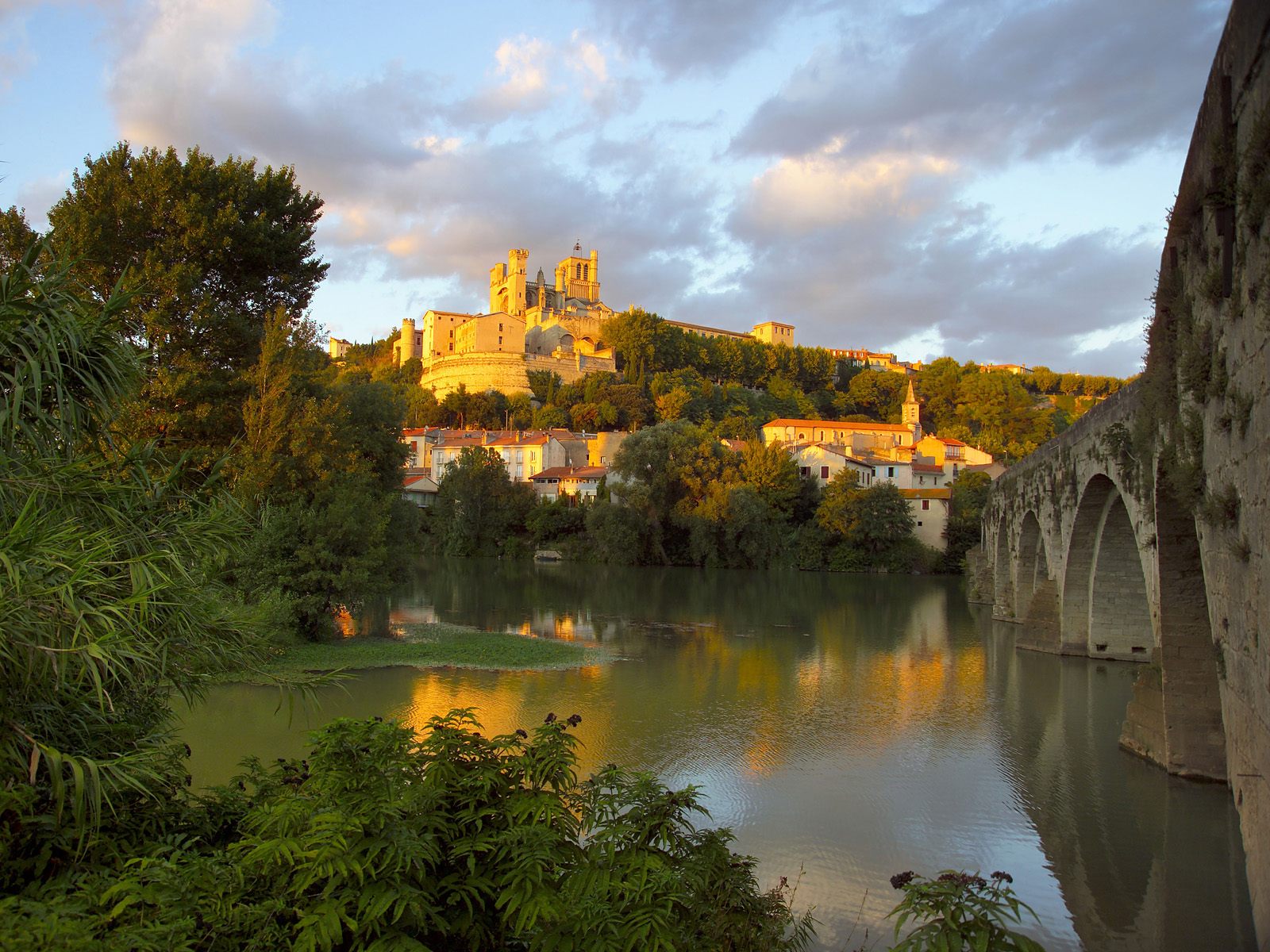| The landscape of Languedoc-Roussillon offers a variety of attractions - wild rocky gorges, fertile orchards and market gardens (the much sought-after primeurs, early vegetables, come from Roussillon), old hill villages, the ruined castles of the Cathars on mountain crags and interesting old towns, as well as the seaside resorts along the coast. The mild climate is a further attraction which draws holidaymakers to this region.
The Languedoc extends from the southern fringe of the Massif Central to the shores of the Mediterranean.
The largest district in the region is the Coteaux du Languedoc. A number of communes in this district have been elevated to the status of Cru, including: Cabrières, La Clape, La Méjanelle, Montpeyroux, Picpoul de Pinet, Pic St-Loup, Quatourze, St-Christol, St-Drézery, St-Georges-d'Orques, St-Saturnin and Veérargues.Another major district within the Languedoc is a hilly area in the west: Corbières. This is an interesting district to explore. It has improved substantially in recent decades, and of note is the influence of Spain in the village architecture and interior of houses.There are Maisons des Vins in the towns of St-Chinian, Olonzac, Béziers, Carcassonne and Lézignan-Corbières which will provide information on visiting châteaux.
St-Gilles lies not far beyond the western border of Provence on the northern edge of the Camargue, 16km/10mi from Arles. The town is primarily important because of its 12th C. church, one of the most important Romanesque buildings in Southern France.
St-Gilles is a starting-point for trips into the Camargue.
In the heart of Saint-Gilles Old Town stands the church, erected in the 12th C. and restored on a smaller scale in the 17th C. The west front is exceptionally fine (the light at its best in the late afternoon) with its three doorways and wealth of decorative figures, which include the first detailed representation of the Passion in Western sculpture. The damage inflicted on the church during the French Revolution makes the importance of its architecture all the more significant.The entrance to the crypt is on the right of the facade. The interior of the church, which has three aisles but no transepts, is characterized by Gothic forms which are surprisingly broad for this period.
In Saint Gilles, to the left of the church facade a narrow lane leads to the ruins of the old Choir, which was destroyed in the 17th C. Here is the Vis de St-Gilles (Screw of St Gilles), a now free-standing staircase dating from the 12th C. The complicated shape of the spiral staircase in the interior of the building is an incredible masterpiece of the stonemason's art. Also to be seen here are the remains of the old apse (the bases of pillars, etc.)
In Saint Gilles, from the open space in front of the church (Place de la République) a narrow lane leads to the charming little Place de l'Olme. Here stands the Maison Romane (Romanesque House) which has capitals decorated with figures to be seen on its first and second storys. Inside there is a museum with an early Christian sarcophagus, relief fragments and a natural history collection. From the hall on the second floor there is a fine view across the roofs of St-Gilles. Immediately adjoining is the tourist office.
Sète (pop. 39,579), situated at the foot of Mont St-Clair, is traversed by many canals. After Narbonne and Aigues-Mortes were cut off from the sea by the accumulation of sand it became the principal port for the North African trade. It is now an important fishing and commercial port. The Vieux Port dates from the time of Louis XIV. From the Môle St-Louis there are fine views of the town and Mont St-Clair (175 m/574ft; views), on the slopes of which is the 18th C. citadel. In the "cimetière marin", the "cemetery by the sea" celebrated by Paul Valéry (1871-1945), a native of Sète, in a famous poem, Valéry himself is buried. Near the cemetery is the Musée Paul-Valéry, with mementos of the poet and exhibits and documents on the history of the town. There is also a room devoted to the singer Georges Brassens (1921-1981), who lived as a boy in Sète and is also buried here.
The sete annual three-week festival takes place in July with a varied program of performances. Musical concerts, as well as theatrical and dance performances are featured throughout the week and the repertoire ranges from classical to contemporary.The Sète Jazz Festival is also included in this bigger event and runs for five days in early July.
Béziers (pop. 71,428), originally a Roman military colony (Biterrae Septimanorum), is finely situated on a hill at the point where the Canal du Midi crosses the river Orb, 15km/9mi from the Golfe du Lion. During the Albigensian wars the town was almost completely destroyed.
In the center of Béziers, running between the old and new towns, is the Allée Paul-Riquet. The church of the Madeleine, originally Romanesque but later altered in Gothic and then Baroque style, was the scene of one of the massacres of the Albigensians in 1209. Farther north is the church of St-Aphrodise (11th-15th C.), which contains a third C. sarcophagus.
In the center of the old town is the 18th C. Hôtel de Ville (Town Hall). The former cathedral of St-Nazaire, situated on higher ground, is a fortified church of the 12th-14th centuries with massive towers and a large rose window on the west front. The Gothic cloister now houses a Musée Lapidaire, with old tombstones and capitals. From the terrace in front of the church there are fine views.
A short distance away is the Musée des Beaux-Arts (pictures, Greek vases). To the southeast, housed in a former Dominican church, is the Musée du Vieux Biterrois et du Vin, a folk museum.
At the south end of the town is the church of St-Jacques, which dates in part from the 12th C. It has a richly decorated choir.
4km/9mi west of the town is the Oppidum d'Ensérune, with the excavations of an Ibero-Greek settlement of the fourth and third centuries B.C. There is a museum displaying finds from the site.
The old town of Narbonne (pop. 46,506), once an important port, now lies 16km/10mi inland as a result of the deposit of silt along the coast. The Canal de la Robine, which links the town with the river Aude and with the Mediterranean, was opened in 1789.
The Roman town of Narbo Martius, founded in 118 B.C., was an entrepôt in the trade between the Mediterranean and the Atlantic and until the fall of the Roman Empire was the seat of the Proconsul of the province of Gallia Narbonnensis. From 413 to 720 it was held by the Visigoths and thereafter by the Saracens, who were defeated by Pépin the Short in 759. In 817 it became the capital of the duchy of Septimania or Gothia; in 843 it passed to Charles the Bald; later it belonged to the Counts of Auvergne and then the Counts of Toulouse; and finally in 1507 it was united with France. Evidence of these vicissitudes is provided by numerous inscriptions, architectural elements and fragments of sculpture.
In Narbonne, on the north side of the Town Hall is the imposing Cathedral of St-Just, with a magnificent choir (at 41 m/135ft one of the highest and largest in France) built between 1272 and 1332 in a bold North French Gothic style; the rest of the building remained unfinished. It has beautiful stained glass (14th C.) and a rich treasury (tapestries, goldsmith's work).
In the southwest of the town is the Early Gothic church of St-Paul-Serge (12th-13th C.), with a fine choir and furnishings. In the Crypte Archéologique are the excavated remains of an Early Christian necropolis (fourth C.). A little way east is the Maison des Trois Nourrices (House of the Three Nurses), a 16th C. house in Renaissance style in which Cinq-Mars, one of the conspirators in a plot against Richelieu, was arrested. Farther east is the old Eglise de Lamourgier (13th- 14th C.), with a battlemented choir. It now contains a Musée Lapidaire with ancient and medieval remains.
Famous for its medieval fortifications, the little town of Aigues-Mortes lies some 30km/20mi east of Montpelier on the western edge of the Camargue, the delta of the Rhône, which is here dotted with numerous lagoons. Two navigable canals, the Chenal Maritime and the Canal du Rhône à Sète, link the town with the sea, 6km/4mi distant.
The town owes its name of the "town of the dead waters" (aquae mortuae) to the bogs and shallow lagoons of the surroundings. St Louis (King Louis IX) possessed no lands bordering on the Mediterranean, so in 1240 he purchased the region from the monks of Psalmody (the remains of their abbey some 4km/2.5mi to the north are being excavated). He then bestowed a number of privileges on the town, which rapidly developed and prospered in the field of commerce and trade as well as in the traditional spheres of fishing and salt-mining. The seventh Crusade in 1248 and the eighth in 1270 sailed from here. The building of the town walls, financed by means of taxes, was expensive and lasted - with some interruptions - from 1266 to the end of the century. At that time Aigues-Mortes had 15,000 inhabitants. It started to decline in the middle of the next century as the waterways gradually silted up, but nevertheless remained an important trading port until the end of the 15th C., when Marseilles was elevated to the status of "royal town".In the Hundred Years War, the great controversy about the succession to the French throne, the Burgundians, supported by England, conquered the town in 1418 and settled here. Afterwards the Gascons laid siege to Aigues-Mortes, penetrated the town one night and defeated the Burgundians. Their corpses were thrown into the southwest tower (now known as the Burgundian Tower) of the town walls and covered with salt in order to prevent decay.In the Wars of Religion Aigues-Mortes became a refuge for the Huguenots, but following the Edict of Nantes in 1685 its towers served as their prison.
The modern holiday center of La Grande-Motte lies on the Golfe du Lion, 10km/6mi west of Aigues-Mortes and 20km/12mi southeast of Montpellier. It is actually not part of Provence but of the adjoining région of Roussillon.
La Grande-Motte came into being in 1974 as the first of the modern holiday centers which are essentially "drawing-board foundations" in the lagoon and dune country west of the Camargue; these centers include Port-Barcarès, Port-Leucate, Valras-Plage and Port-Camargue. It has developed into a huge holiday town, with a sophisticated infrastructure of accommodation, and entertainment and sporting facilities.The place is grouped around the well-equipped marina, on both sides of which stretches a beach of fine sand. The typical silhouette is formed by pyramid-shaped blocks of apartments. On the east side of the harbor is a fine aquarium with more than 30 tanks.To the north and east of the main road through the town are holiday houses, various sports centers and a holiday village.In the nearby lagoons, Etang du Ponant and Etang de Mauguio, fairly large groups of flamingoes can be observed. Here there are also opportunities for water sports and fishing.
10-6-17
|






